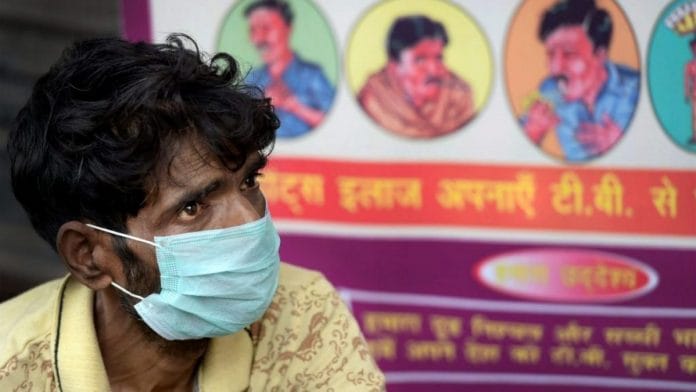New Delhi: Union Health Minister J.P. Nadda will endeavour to revise India’s target to eliminate tuberculosis (TB) by 2025, which was ambitiously set five years ahead of the global target by PM Narendra Modi in 2018, ThePrint has learnt.
Considered a TB-endemic country, India reports the highest number of TB deaths globally every year. As per the World Health Organization’s Global TB report in 2023, the country accounted for 28 lakh cases, which is 27 percent of the global burden. There were over 3.31 lakh deaths in 2022.
TB is a highly infectious disease caused by a bacteria called Bacillus Mycobacterium Tuberculosis, which is spread when people who are sick with TB expel the bacteria into the air (mostly by coughing).
Top officials in the health ministry told ThePrint that a high-level meeting would be held in the coming days to revise the TB elimination target, which would then also be discussed with the Prime Minister’s Office.
“A target to ‘End TB’ by 2025 was set for the country at the highest level. But there have been slip-ups in our elimination efforts and now the target will be revised for 2027 or 2028,” a senior official in the ministry conceded.
“We have definitely made big strides in curbing the disease to some extent but the Covid-19 pandemic was a major setback. We, therefore, need to make some realistic changes in the current National TB Elimination Programme (NTEP),” a second official said, adding that all this would be discussed in a meeting chaired by the new health minister.
ThePrint reached out to Union health secretary Apurva Chandra for his comments, but is yet to receive a response.
The United Nations’ indicators for TB includes an 80 percent reduction in incidence rate (new cases per lakh population) compared with levels in 2015, a 90% reduction in the TB mortality rate compared with levels in 2015 and zero TB-affected households suffering from catastrophic expenses due to the disease.
But the Indian government’s TB report, released in March, showed that its efforts to curb the infectious disease has resulted in a decline of only 16 percent in TB incidence (new cases emerging each year) and an 18 percent reduction in mortality due to TB, since 2015.
This report also showed that the incidence rate of the disease in 2022 was 199 per lakh population, while the deaths stood at 23 per lakh population. That year, the country also registered nearly 70,000 drug-resistant TB cases, presenting another challenge in India’s fight against the bacterial disease.
From 2012, TB has been a notifiable disease in India which means that all cases of TB diagnosed by any means — even those by doctors in the private sector — have to be reported to the public health authorities.
Also read: AB-PMJAY expansion to 4.5 cr people aged over 70 likely as Nadda takes charge of health ministry
Challenges galore
Government officials maintained that the NTEP programme ran on strategic pillars of “detect-treat-prevent-build” and as a result, the country managed to narrow the gap between targets and achievements and was also one of the first countries to have developed its mathematical model for burden estimates.
“For instance, in India a 16 percent decline (between 2015 and 2022) in estimated TB incidence has been higher than the global decline of 9 percent,” an official associated with NTEP told ThePrint.
“Yet, it is way lower than what the ideal figure would have been,” he said, also pointing out that the country had failed to achieve the target of bringing down the TB mortality rate to 6 per lakh population as targeted for 2023 and last year it stood at 23 deaths per 100,000.
In March, TB researchers Dr Anurag Bhargava, Dr Madhukar Pai and Dr Madhvi Bhargava wrote in The Lancet that TB was a “curable infectious disease linked to inequities”.
“Socioeconomic conditions create vulnerabilities to the disease and its catastrophic outcomes. Socially determined biological risk factors such as undernutrition (associated with poverty) and HIV are major drivers of tuberculosis in southeast Asia and Africa,” they wrote.
But some others pointed out that India’s elimination targets need to address barriers to access to diagnosis and treatment
“Shortages and stock-outs of testing kits and TB drug regimens as experienced earlier this year, are frequent and need to be addressed as they undermine India’s efforts to address TB,” said Leena Menghaney, a lawyer working on public health and access to medicines.
Lab facilities and transport of sputum in remote areas – rural and tribal – are a problem that need to be addressed, she said, adding the lack of appropriate diagnostic tools for children with TB led to cases in this vulnerable population being missed.
“X-ray is an important screening tool in high burden settings. Free X-ray available once TB is diagnosed but not before that can be a barrier for the most vulnerable. Also, access to XDR-kits and short oral regimens (BPaLM) for DR-TB are critical to effectively diagnose and treat DR-TB,” Meghaney said.
She also stressed that bridging attrition of patients from the point of suspicion to actual diagnosis and treatment is critical to ensure that TB cases were not lost to follow-up.
Mumbai-based infectious disease specialist Dr Ishwar Gilada said that elimination targets for diseases are sometimes set to “activise and energise the machinery”. “To that extent, NTEP has fulfilled its aim. Also, the programme has seen one of the most successful examples of public-private partnership in the country,” he said.
Dr Gilada added that some inherent challenges, such as lack of tests to detect latent TB cases and management of supply chains to ensure access to crucial drugs, had not been effectively managed.
(Edited by Tikli Basu)
Also read: Ultrasound that doesn’t reveal sex of foetus in the works & what it means for pregnant women






